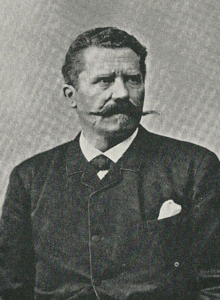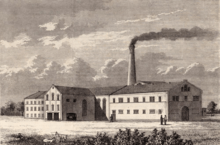Erhard Frederiksen
Erhard Frederiksen (7 November 1843 - 12 October 1903) was a Danish agronomist and sugar manufacturer. He is considered one of the most significant writers on agricultural economics of his time in Denmark. He was in 1872-74 a co-founder of a sugar factory at Holeby on Lolland which was later taken over by the Danish Sugar Factories under the name Højbygaard Sugar Factory.
Erhard Frederiksen | |
|---|---|
 | |
| Born | 7 November 1843 |
| Died | 12 October 1903 (aged 59) Vordingborg, Denmark |
| Nationality | Danish |
| Occupation | Agricultural economist |
| Awards | Knight of the Dannebrog, 1897 |
Early life and education
Frederiksen was born at Fuglsang, the son of Ditlev Friderichsen (1791-1861), the owner of Nøbbøllegård, and wife Maria Hansen (1811-1901). He was the brother of Johan Ditlved Frederiksen, Kirstine Frederiksen and Niels Christian Frederiksen.
Frederiksen graduated from Sorø Academy in 1857 and then spent two years on his father's estate to obtain practical experience with farming before enrolling at the Royal Danish Agricultural College from where he graduated as an agricultural economist in 1862. In 1862-63, he then worked under Edward Tesdorpf as assistant manager at Ourupgård. He was also introduced to the dairy business by Thomas Riise Segelcke and visited a number of the most innovative agricultural estates across Denmark. He also studied the latest trends in agriculture on a study trip to Germany, the Netherlands, Belgium, England and Scotland.[1]
Early career in agriculture
Frederiksen managed Nøbbøllegård for his mother from 1863 after his father had died in 1861 and became the owner of the estate in 1866. He enthusiastically introduced and experimented with many of the new technologies and principals that he had studied at the Royal Agricultural College and abroad.[1]

His brother, Johan Ditlved Frederiksen, in 1871, returned from a journey to Germany where he had studied sugar production based on sugar beats. The two brothers constructed the Lolland Sugar Factory in 1982-74 but was hit hard by a combination of unfortunate circumstances. The 1872 Baltic Sea flood flooded much of Lolland and a new tax on sugar beats was in the same time introduced in 1973. It also turned out to be more difficult than expected to convince local farmers to grow sugar beats for the production. Industribanken cancelled their credit in 1876 and the company went bankrupt the following year. Frederiksen also lost his estate which was taken over by Privatbanken. The factory was reopened by C. F. Tietgen's Danish Sugar Factories under the name Højbygaard Sugar Factory in 1880.[2]
In 1878, Frederiksen was a co-founder and the first managing director of Københavns Mælkeforsyning. In 1870-80, he visited England and Alsace-Lorraine on a government stipend to study malted barley. He instigated annual malt barley exhibitions and that Landhusholdningsselskabet in 1883 a malt barley committee of which he was an active member.
Writer and editor in Copenhagen
After his bankruptcy, Frederiksen began a career as a writer and editor in Copenhagen. His brother-in-law, V. Topsøe, editor-in-chief of Dagbladet, invited him to become editor of a new agriculture supplement in 1984. In 1879, he started the publication of Landbrugstidende but it merged with Ugeskrift for Landmænd when he was appointed as co-editor the following year. He remained in the position until 1 January 1904. He also wrote for other magazines and contributed to E. Møller-Holst's Landbrugs-Ordbog.
Back to Lolland
In 1882, C. F. Tietgen offered him a position as a consultant for De Danske Sukkerfabrikker. Frederiksen resided at Svingelgård at Nakskov where he engaged in breeding of barley and sugar beat varieties besides his work as consultant and co-editor of Ugeskrift for Landmænd. He was a member of the Seed Control Commission ( Frøkontrolkommissionen) and co-founded Foreningen af danske landbrugskandidater in 1897 and served on the board until his death.[1]
Personal life
Already as a young student in Copenhagen, Frederiksen moved in the highest intellectualcircles. He was a frequent visitor in the homes of prominebt cultural and political figures such as Ditlev Gothard Monrad, Carl Ploug, Niels Laurits Høyen and Constantin Hansen.[1]
He married Sigrid Marie Elisabeth Topsøe (1844-1925, herredsfoged, kancelliråd Søren Christian Topsøe (1797-1847) and Sigrid Christine Gudrun Thorgrimsen (1813–86), on 28 May 1874 in the Church of Holmen in Copenhagen. He was the father of V. Erhard-Frederiksen.[1]
Frederiksen was awarded the Order of the Dannebrog] in 1897. He died on 12 October 1903 and is buried at Vestre Cemetery in Copenhagen.[3] In 1917, farmers on Lolland erected a memorial to Frederiksen outside Maribo. It was designed by H. C. Glahn and is located at the junction between the roads to Nakskov and Rødby.
References
- "Erhard Frederiksen" (in Danish). Dansk Biografisk Leksikon. Retrieved 3 February 2019.
- "Højbygaard Sukkerfabrik". jernbanen.dk (in Danish). Retrieved 2 February 2019.
- "Erhard Frederiksen". gravsted.dk (in Danish). Retrieved 3 February 2019.
External links
- Christian Erhard Frederiksen at geni.com